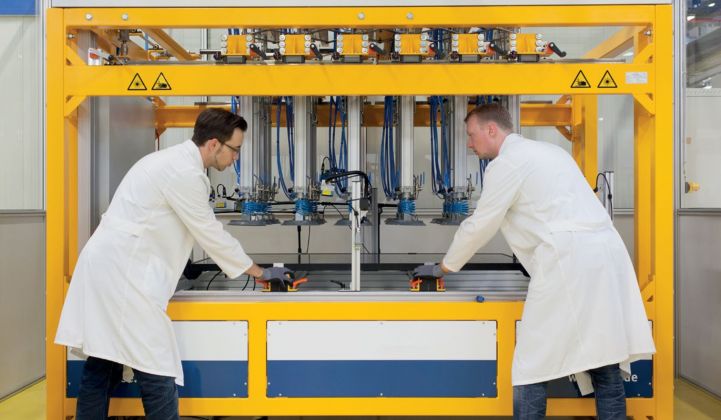A representative of the Trump administration and Georgia Governor Brian Kemp will converge on Dalton, Georgia on Friday to celebrate a U.S. manufacturing win, as Hanwha Q Cells officially opens its solar module manufacturing facility in the state.
The 1.7-gigawatt module facility is one success the administration can claim from its trade war, which has thrown several markets — including solar, for a time — into turmoil.
Hanwha Q Cells announced plans for the Georgia factory in May 2018, just months after the Trump administration finally instituted a 30 percent step-down tariff on imported solar cells and modules. At the time, Hanwha said the plant would serve as a “testament to Hanwha Q Cells...commitment to the U.S. market, in spite of the recently imposed trade barriers.” It’s now the largest solar facility in the entire Western hemisphere and employs 650 people.
“The administration signaled that they very much wanted to develop an American solar manufacturing industry, and we responded to that — as have several others,” said Scott Moskowitz, director of strategy and market intelligence at the South Korea-headquartered Hanwha Q Cells. “We’ve seen a real resurgence in American solar manufacturing.”
The U.S. is Hanwha’s largest market, and the Georgia plant will fulfill the majority of Hanwha's solar shipments to the U.S. In addition to its Georgia site, the company manufactures in South Korea, Malaysia and China.
Tariffs' fading importance
Though companies such as Hanwha have been quietly working to ramp the facilities announced since the tariffs, by this point the solar market has largely moved beyond the relatively muted impacts of the Trump administration's Section 201 tariffs. The industry hasn’t forgotten the tariffs, but their relevance has certainly faded, overshadowed by more pressing policy struggles like an extension of the federal Investment Tax Credit.
The Section 201 tariffs are currently under midterm review by the administration, but based on the existing schedule, tariffs have already stepped down to 25 percent. They'll continue declining to 15 percent in their final and fourth year, before dissolving entirely.
That timeline means the Hanwha plant, in addition to those announced by LG Solar, First Solar and Jinko — all in various stages of production — will ramp just as the tariffs decline. Xiaojing Sun, a senior solar analyst with Wood Mackenzie Power & Renewables, said manufacturers did their best to make educated choices around manufacturing in the short term, also noting that the tricky timing underscores the importance of clear policy for the solar industry.
“What it highlights is that policy uncertainty, or lack thereof, is really a big challenge for any sort of manufacturing business in the U.S.,” said Sun. “All of these headaches that we’re talking about were created by policy.”
Manufacturers that chose to invest in U.S.-based production got another shock in June, when the administration announced an exemption from the tariffs for bifacial modules. Companies such as First Solar expressed dismay with the decision.
“The disappointing decision, which in our view has the effect of undermining the administration's efforts to secure a level playing field for U.S. solar manufacturing, introduces a new source of uncertainty going forward,” said First Solar CEO Mark Widmar on the company’s Q2 earnings call.
Because bifacial modules are most suited to utility-scale applications, Sun said the exemption will have an outsize impact on companies selling into that market.
Moskowitz declined to comment on whether Hanwha plans to produce bifacial modules in Georgia.
Though the bifacial exemption dragged solar tariffs back into the news, the industry's lobbying efforts remain mostly focused on an extension of its tax credit. As Section 201 tariffs wind down in 2022, the tax credit will also drop to a permanent 10 percent for commercial and utility-scale installations.
***
Related research: 'U.S. Solar Market Insight' (Wood Mackenzie)




